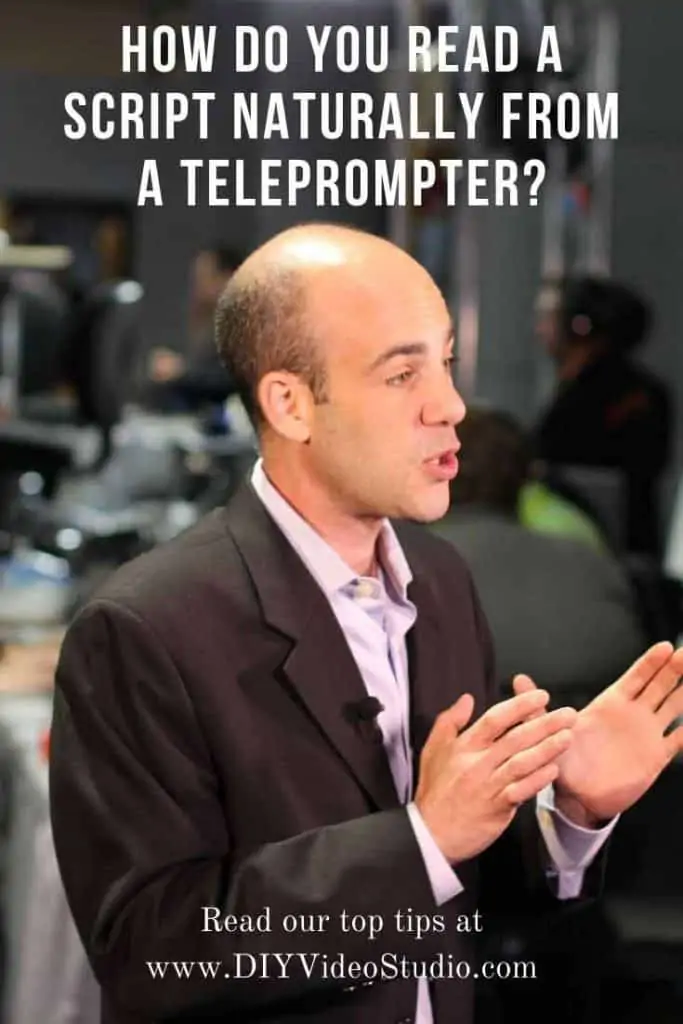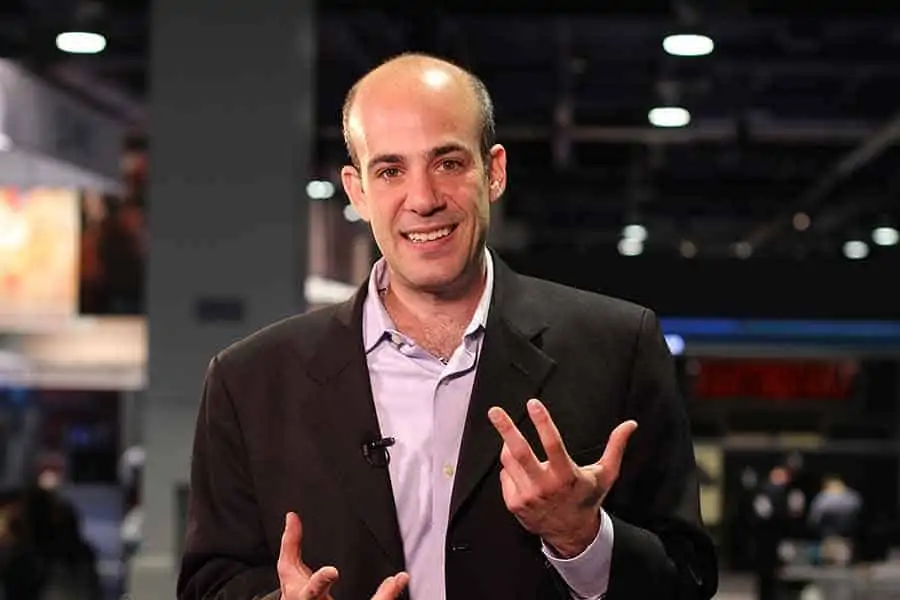DIY Video Studio is supported by its readers. Please assume links on this site are affiliate links or ads, and that I get commissions for purchases made through these links. As an Amazon Associate, I earn from qualifying purchases. Thank you if you use any of the links.
A teleprompter can help you read all the words of your script, but unless you use it correctly you could end up sounding as if you’re mechanically reading off a page.
The skill in using a teleprompter is to use it as a tool that makes your presentation seem natural and professional. Now I hear you say, that’s easy for me to write, but how can you put that into practice and nail that skill?
If you feel awkward and nervous the first time you try using a teleprompter there are a few things you can do to ensure your presentation is as natural as possible. Let me go through each of them with you.

1: Write your script for the spoken word
There are many writing styles, and you normally write in a style that matches the end purpose. For instance, if you’re writing an essay or paper for school or college it’s probably going to be formal. But if you’re writing for a social media post your style will likely be informal and friendly.
Likewise, when you’re writing copy for a video script make sure you write in a style that’s like the way you would speak. When it comes to recording your video, you’ll find it much easier to read copy that has been written to be spoken aloud than something that sounds like a formal essay.
Use the kind of language and phrasing you would use in your normal daily speech. Even if your video is targeting people in your own industry, if possible, avoid industry buzz words and specialist language. Try keeping things simple so they are easy to understand, you’ll be a more effective communicator if you do so.
2: Familiarize yourself with the script
If you didn’t write your own script, make sure you familiarize yourself with it before recording. I’ve worked with clients who frequently don’t bother to check out their scripts prior to recording and are then surprised when they find they have a hard time making their performance sound natural.
Before you get anywhere near the camera, make sure you’ve read through the script, so you know exactly what to expect. I don’t mean reading the script just before pressing the record button, read through at least a few hours beforehand, ideally do it the day before.
3: Adjust the text formatting on the teleprompter
Most teleprompter apps allow you to change the way the text is displayed, and that can help you see the script more clearly. When it’s easy to read your lines, you can relax and make the script sound more natural.
Often you can change the text and background colors, the font, and font size. Your choice can make a big difference to the ease of reading.
4: Try to relax and be comfortable
Standing for your piece to camera frequently improves your delivery. By standing your breathing will be less constricted and you’ll find it easier to speak your lines.
Watch what you wear. Avoid clothing that makes you feel uncomfortable since you’ll unconsciously communicate that feeling to your audience, making them feel a little awkward.
Before you start you may also find taking a few deep breaths helps you relax. Breath in through your nose and blow slowly out through your mouth. If you’re familiar with the breathing exercises for ladies giving birth.
Try and avoid any distractions. If there’s something that’s just in your line-of-sight that’s putting you off see about removing it.
5: Understand and own the script
Don’t just read the words, own them. Make sure it sounds like you know what you’re speaking about and not just reading the lines. If you are reading someone else’s script, you will find it easier to read if you can make minor changes to the wording or phrasing so it sounds more like the way you would speak. If the script doesn’t sound like you, you’ll never be able to read it naturally.
Practice the script and put an emphasis on the key word or words in each line. At the end of a sentence put a little “punch” on the last word to audibly indicate that it’s the end of the phrase. This may also be combined with an upward or downward slide in the pitch.
To make your read sound more natural you should also change your pace, so it reflects the level of excitement of the content. In a conversation, you might pick up the pace if excited about what you’re talking about, do the same when reading your script.
Of course, you cannot read the entire script at a high-octane pace. It’s the variation you include in your presentation that helps to add interest for the listener and makes you an engaging speaker. Also, don’t be afraid to use pauses for dramatic effect. You don’t have to fill every silence with speech.
6: Practice aloud until you sound perfect
You’ve probably heard the adage that practice makes perfect. It also true when performing in front of a camera.
Practice not only makes you familiar with your lines, but you’ll also understand exactly how best to phrase each line. You might even bring your natural creativity to bare and add one or two small embellishments to your performance.
Practicing, or rehearsing, will give you the confidence to step in front of the camera and record a natural performance.
If possible, practice using the teleprompter you’ll be using. I often find that making tiny changes to the way the text is laid out on screen can help my performance. The thing is, you only discover those tiny issues when you start practicing, and it’s easier to make those adjustments in your rehearsal than during the production of your video.
7: Be a little larger than life
Make sure you bring yourself to the “party”, you’ll feel more comfortable, and your performance will be more enjoyable for the viewer.
You may have heard that appearing on TV and video makes you look about 10 pounds heavier. Whether that’s true isn’t really the point here, what I would say is that the natural “you” often becomes a dull you in a recording.
When recording a video be yourself and then some. Exaggerate your natural way of speaking and your body language. Be just a little bit over the top in your presentation. When you watch the recording, you’ll frequently notice what you thought was too big a performance was just right. If you get it wrong, you can always do a retake and pull back those newly found extrovert tendencies.
8: Accept that you don’t have to be perfect
When you’re starting out you don’t have to be perfect on camera. In my professional broadcasting career, I’ve only met a small handful of people who were naturals from the get-go. Most pro presenters take time to form their polished onscreen personas. So, don’t worry that you can’t nail every tiny detail in your video. You really don’t have to be word perfect; no one is expecting that except you.
Once you accept that you don’t have to be perfect you can relax and enjoy the video production process. Now here’s the interesting thing, when you accept that you don’t have to be perfect you will take away the pressure you had previously put on your shoulders. Without that self-imposed pressure, you’ll find it easier to read your script more naturally.
Now just keep going, and with each new video, you’ll get better as you become more comfortable and learn how to communicate with your viewers.
9: Smile and make yourself feel better
If you feel stressed, you’ll not be able to read your script and make it sound natural. Of course, the opposite is also true.
One way you can reduce that stress is by smiling. I know that sounds weird, but research has shown that smiling causes the release of the feel-good chemicals in your brain, like endorphins and serotonin. The natural high helps raise your mood and relaxes you. According to Dr. Sivan Finkel, from The Dental Parlour, “Even forcing a fake smile can legitimately reduce stress and lower your heart rate.”
So, the message is clear. Smile to de-stress, you’ll feel a lot happier and that will help you sound a lot more natural when reading from a teleprompter.
10: Use the teleprompter’s technology to be more natural
In a professional video studio, the teleprompter is frequently controlled by a teleprompter operator. Their job is to make sure the text on the screen matches your pace of delivery. This might mean they slow down the scroll speed at some points but speed up at others.
However, when you’re working in a small studio on your own you won’t have the luxury of a teleprompter operator. But don’t worry, you can still include a natural variability in your pace without losing your place in the script.
One simple strategy is the increase the scroll speed slightly to match your fastest pace and then add line spaces where you will slow down your presentation. Unfortunately, this is a trial-and-error method that will take up a bit of time.
A better way of accommodating your variable presentation pace is to use the technology in the teleprompter app. Although often this means spending a little on a paid-for app.
If you are going to frame your shot so that your hands aren’t visible or you’re able to keep one of your hands out of the shot, consider using a remote control that allows you to start/pause or speed-up/slow-down the text scrolling across the teleprompter’s screen.
A more elegant method is to use a teleprompter app that includes speech recognition to scroll your script. It’s like having a teleprompter operator inside your phone or tablet.
All these methods not only allow you to vary your pace but also improvise if necessary. You can add something to the script by pausing the script and then restarting it when necessary. In the case of an app with speech recognition, it’ll wait until it hears you return to the wording in your script.
Conclusion
So, if you want to be able to read a script naturally from a teleprompter make sure your script has been written in an informal way that matches the way you speak normally. Do your best to be comfortable and confident in front of the camera. And use the technology to best effect to help you achieve your goal.
Above all, remember that no one is ever perfect the first time they try reading from a teleprompter. It takes practice, so give yourself a break and just let yourself improve over time.
Tosh Lubek runs an audio and video production business in the UK and has been using the Canon EOS R since it was released in the Autumn of 2018. He has used the camera to shoot TV commercials for Sky TV, promotional business videos, videos of events and functions, and YouTube creator content. He has also won international awards for his advertising and promotional work. You can meet him by visiting his “video booth” at HashTag business events across the country.
Recent Posts
Recently, I shot several customer testimonial videos in 4K for a client when the overheating warning on my Canon EOS R6 appeared. In fact, it appeared three times in five sessions during the day of...
Why Every Photographer Should Have a Nifty-Fifty 50mm f/1.8 Lens
If there’s one lens nearly every photographer should own, it’s the 50mm f/1.8 - better known as the “nifty fifty.” This affordable lens provides impressive quality and versatility, making it...



